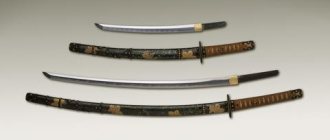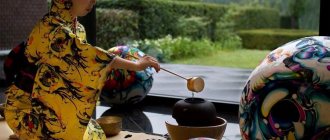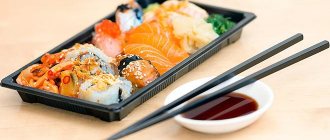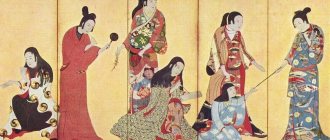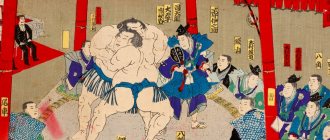Combat characteristics of swords Other medieval Japanese swords
Tanto Wakizashi Tachi Ninja-to Tsurugi Gun-to Bokken Naginata
Features of making a Japanese sword with your own hands The difference between the Japanese katana and its European counterparts Advantages and disadvantages
Numerous wars and conflicts of Antiquity and the Middle Ages influenced not only the political structure of the world, but also the development of blacksmithing. Since battles were often decided by hand-to-hand combat, the emphasis was on improving melee weapons.
Throughout Europe and Asia, the art of forging was improved, achieving significant progress in some regions. Many technologies of those times made it possible to create high-quality swords, the hardening of which is superior to modern industrial products.
Katana is one of the Japanese swords famous for its quality. This weapon is credited with mythical properties and has become famous all over the world. Despite the lack of demand for edged weapons today, such swords continue to be forged as part of the cultural heritage of Japan.
The history of the appearance of the sword "Katana"
Katana and scabbard on a stand
Due to the late development of iron in Japan, weapons were imported from China and Korea for a long time. Only by the 7th century were blacksmiths able to master forging and processing multilayer steel. The first Japanese swords were straight and double-edged.
During the Heian period, in the 9th-12th centuries, in the context of horse fighting, weapons received a curved shape. Numerous internecine wars formed an entire class of samurai, for whom the sword became not only a weapon, but also a symbol. It was during this period that manufacturing technology was perfected.
During the Kamakura period from the 12th to the 14th centuries, armor improved, which required certain changes in bladed weapons. To increase the impact force, the weight increased and its shape changed. Such swords began to be used mainly in foot fights due to the complexity of fencing with one hand. This period is considered the heyday in the development of Japanese swords. Blacksmiths used unique technologies, many of which were subsequently lost.
During the Muromachi period from the 14th to the 16th centuries, various variations of Japanese swords appeared. Numerous wars required large quantities of edged weapons, and their quality has noticeably decreased. They were not allowed to purchase expensive weapons and constant ruin.
It was during this period that katanas developed. Their relevance arose against the backdrop of changes in fighting techniques, in which it was more important to get ahead of the opponent and strike the first blow. The appearance of slightly shorter swords marked the end of the Age of Old Swords.
The Momoyama period in the 16th century is characterized by the appearance of short swords. From this time on, wearing daisho (large-small) - katana and wakizashi - became relevant. The latter was more suitable for tight spaces.
This period marked the beginning of the Age of New Swords. Internecine wars subsided; peacetime no longer required large quantities of edged weapons. Japanese swords became part of the costume and a symbol of the owner's status. They were decorated with trim and decorative elements, often to the detriment of their fighting qualities.
In the second half of the 19th century, the Age of Modern Swords began. Weapons produced after 1868 are called gendai-to. Due to the ban on wearing it in 1876, many blacksmiths remained unclaimed, which led to a decline in production. At the beginning of the 20th century, in the context of a campaign to revive the country's cultural heritage, blacksmiths again received support.
bokken
bokken
- in Russian, often pronounced boken (Japanese: 木剣), a wooden training sword. It was introduced into use by the sword master Miyamoto Musashi for training. It was also used in fights so as not to kill your opponent. Although in skillful hands, a bokken (also called a bokuto, Japanese 木刀 “wooden sword”) killed and maimed no worse than a sharpened katana.
Bokkens are made from oak, beech, hornbeam and other dense woods. They are often impregnated with varnish, stain or wood resin for greater density and weight. The total length of the bokken is approximately 95-105 cm. The length of the handle is about 25-27 cm, the length of the blade is 76-78 cm. The bokken must be strong enough to withstand strong blows to anything, as well as repelling an attack from another bokken or jo.
A well-placed blow to a person with a bokken can lead to death. The great Japanese swordsman Miyamoto Musashi (1584–1645) often used bokken in actual fights, killing his opponents in most cases. The tip of the blade is most dangerous when delivering slashing blows.
In Japan, bokken are treated with great respect, almost like real weapons. When carrying a bokken on an airplane, the passenger must check it in as baggage. And wearing it without a special case by the Japanese themselves is equivalent to carrying a bladed weapon.
Varieties:
- “male” (Japanese 男子木剣 danshi bokken), distinguished by a relatively thick handle and “blade”, straightness and a thick wooden guard (tsuba).
- “female” (Japanese: 女子木剣 joshi bokken), the most commonly used option. It is distinguished by its curvature and lightness. Often used with a plastic guard and sheath (for example, in Iaido).
- “training” (Japanese 素振木剣 suburi bokken) or suburito, is distinguished by thickening on the tip side, thus imitating the balancing of a real sword.
Different schools use different types of bokken for training:
In Katori Shinto Ryu, it is customary to use a bokken with less bending, sometimes without it at all. Thicker and heavier.
The bokken used in Iwama Ryu (as well as the bokken used in other aikido styles), unlike the previous one, has a more graceful shape and a more pronounced bend.
The bokken in Kashima Shin Ryu (as well as in most kendo schools), unlike the previous two, has the closest resemblance in shape, balance and feel to a real katana.
Sword design
The design of the katana has many elements
Katana belongs to the composite swords made from several metals. Often two alloys are taken - soft for the core and hard for the outer side. The final design of the weapon is divided into many elements that determine the quality of the sword.
The general appearance of the katana has a slightly curved shape. The arc formed has a larger radius than its predecessor, tati. The curve of the sword (sori) is a consequence of the evolution of Japanese weapons and fighting techniques. Experiments were carried out in this direction for a long time until the current variation was achieved.
Blade
Components of a katana blade
The combination of a soft (viscous) core and a hard (hard) shell provides the weapon with long-term sharpness and toughness. Otherwise, hard steel would be brittle, and soft steel would quickly wear off.
The katana blade is sharpened only on one outer side. Numerous myths attribute phenomenal abilities to samurai swords, including cutting iron and stone. A carefully crafted and hardened katana blade is indeed highly durable, but its properties are often exaggerated.
The katana does not have clearly defined standards for bending, cross-section, thickness and other elements. They differ depending on the master, the blacksmith school and the purpose of the blade. For example, against armor the sword was made heavier with a wedge-shaped cross-section, and against opponents unprotected by armor a thin blade was suitable.
Handle
Handle elements
Making the handle is considered the final stage of creating a sword and follows after polishing the blade. The handle is secured to the shank using a conical bamboo wedge. Despite the apparent simplicity of the design, there are several components of the handle:
habaki - a clutch that fixes the position of the sword; tsuba—guard; seppa - washers above and below the guard; footi - coupling between the guard and the handle; Samegawa - handle coating; tsuko-ito - braided braid; menuki - decorative inserts; kashira - a cap at the end of the handle.
The primary covering of the handle is made from the skin of a stingray or other sea animal. Silk or leather is used as braid, and wool is used for decorative decorations. Modern swords are trimmed with artificial silk. All decorations and decorative elements are made in the same style.
Sharpening
Sharpening a katana is carried out together with grinding; this process is often carried out by another master - togishi. First, he polishes and sharpens the blade of the weapon with coarse stones, and gradually moves on to finer ones. This procedure takes about 120 hours.
As the sharpening progresses, the master determines the structure of the metal and the forging technique. At this stage, minor defects that arose during the manufacturing process are eliminated. An important aspect of the work is the preservation of the style of the blacksmith who made the blade. This should be especially taken into account in the decoration of weapons and their aesthetic beauty.
Engravings
The engraving is applied by the master after polishing to the unhardened areas of the sword. This element is considered decorative; combat katanas are rarely decorated. On modern weapons, engraving is carried out mainly on Buddhist themes.
Dimensions and weight
Comparison of Japanese weapon sizes
The katana does not have precise standardized dimensions and weight. Hand-made weapons imply the individuality of each sword. However, there are certain frameworks by which katanas are distinguished from other types of Japanese weapons.
The length of the blade varies from 60 to 75 cm (2-2.5 shaku). The total length with the handle ranges from 85 to 105 cm. If the length is less than the established size, it is a wakizashi. If more - o-katana. If there is a larger bend and size, the sword is classified as tachi.
Depending on the craftsman and the tradition of katana making, the weight of the weapon differs. The approximate range is 0.7-1 kg. The mass differs not only from the size, but also from the metal used and the technique of its processing.
History of creation
The katana was first mentioned in sources in the 15th century. Japanese warriors before her already carried weapons - a tachi, which was hung on a belt, an okatana (a larger sword). The katana became more of a modified modification of the tati. Only samurai were allowed to carry a katana and use it for its intended purpose. Of course, they also had other types of weapons - bows, arrows, spears. But none of them gained such popularity as the long, slightly curved sword carried at the samurai's belt. It was not so much its use as the creation process that raised a lot of questions. The bond between the katana and the samurai welder was sacred.
It was believed that the sword contained the soul of a warrior, so it was used only in the most extreme cases - for example, a katana can be used in matters of honor (which could include saving a noble or family members, protection from certain death). There were also cases when sausage was chopped with a katana for dinner or lunch. This may seem like downright stupidity to some, but samurai treated their sword like their soul, so using a katana as a kitchen knife was acceptable if the warrior was really hungry.
Combat characteristics of swords
The combat characteristics of Japanese swords are largely exaggerated. The exoticism of culture and military traditions have created many myths around the power of this weapon. In practice, after a series of examinations also carried out by Japanese experts, it was found that medieval European blacksmiths often achieved the same quality as Japanese ones.
The key feature of the Japanese sword is its fencing technique. The katana is used as both a two-handed and one-handed weapon. The main purpose is to deliver cutting blows, and in rare cases, piercing blows.
The blow is ensured by the movement of the sword along the plane of the longitudinal axis. The curved shape of the weapon allows for quick cuts. Given the weapon's sufficient weight, such blows could cut through traditional Japanese armor. However, the myths that katanas easily cut iron and other materials have no practical confirmation.
Other medieval Japanese swords
The combination of hard and soft metals in the design of the katana could have different variations
The question of what is the name of a samurai sword does not always have one answer. Taking into account the long evolution of Japanese weapons, several types have emerged, differing both in size and in application. Often any Japanese blade is called a katana, but such a definition is not entirely correct. Each type of weapon has its own purpose and tradition of use.
Tanto
Tanto is an auxiliary knife or dagger, up to 30 cm long. It was used by warriors to cut off heads or to commit hara-kiri.
Wakizashi
Wakizashi is a shortened katana with a blade length from 30 to 60 cm. This sword was used in tight spaces as an independent weapon. Some fencing techniques involve the simultaneous use of a katana and a wakizashi. Both weapons became indispensable attributes of the traditional samurai costume. At the same time, warriors who did not belong to the samurai class could also wear wakizashi.
Tati
Tati is a long sword with a blade size of 75 cm. In fact, this weapon became the first Japanese sword used in horse battles. Depending on the size, there are several subspecies of tati. The longest are o-dachi with a blade of 2.25 m.
Ninja
Ninja was also called shinobi-gatana. It is similar in design to a regular katana, but its blade is shorter and its sheath is thicker. This was done for the convenience of covert movement, while auxiliary tools for espionage operations were stored in the sheath.
Tsurugi
Tsurugi are the first Japanese swords, used until the 10th century. Their key feature is a straight, double-edged blade. This term is often used to refer to any ancient swords.
Gong-to
Gongto are industrial swords that were manufactured in mass production in the first half of the 20th century. Made for the army and navy.
Bokken
Bokken is a wooden training sword. He enjoyed no less respect than military weapons.
Naginata
In Japanese classification, the naginata is considered a sword, although in practice this weapon is closer to a polearm and resembles a European glaive. The slightly curved blade was mounted on a two-meter shaft. This type of weapon has its own fencing techniques, battles using which still take place today.
Interesting Facts
Curious to know:
- the purpose of the sword’s existence is to protect the master, the samurai’s relatives;
- the scenes of cutting a silk scarf shown in popular films are true - the blade actually cuts the thin fabric on the fly;
- now the katana is a work of art, not a weapon;
- the traditional clothing of a blacksmith in Japan is a white dogi outfit, symbolizing the purity of the thoughts of the forger;
- To create one sword, several blacksmiths are sometimes involved;
- learning forging requires at least 7 years, of which the first three years students perform auxiliary work and do not touch the tools.
Katana - a reflection of the samurai's soul
How much does a katana cost?
Japanese products are expensive things. A well-made copy will cost tens or hundreds of thousands of American dollars. Cheap models are souvenir items made in Chinese factories. The most expensive sword in the history of the market - made in the 13th century and bought by an anonymous European collector for $418,000.
Common defects
Typical defects caused by forging and the nuances of the material used:
- sinae - minor imperfections due to metal fatigue at bending points;
- karasunokuchi – cracks (critical if they divide the hardened and unhardened parts);
- umegane - patches that hide internal steel or a defect;
- hagire – small cracks (almost invisible hagire are considered dangerous);
- mizukage - darkening on the cutting part;
- hajimi – matte zones;
- fukure - coal, scale due to poor quality welding;
- tsukare – a violation of proportions (reduction in thickness) due to frequent sharpening.
Katana sheath
Sayas are used to store a katana. In the past, they were made from magnolia, decorated with varnish to protect them from moisture, and decorated with lacquer miniatures, leather, and gold. In the 20th century, sai was made from metal in factories.
Some sayas are works of art
Longest Katana
The longest subtype of katana is the odachi. Its total length reaches 180 cm, the blade ranges from 120-150 cm. Odachi is designed to be carried in the hand.
The predecessor of the tachi katana reaches 2.25 m in length.
Features of making a Japanese sword with your own hands
Modern Japanese swords are a work of art
The process of making a katana by Japanese blacksmiths was distinguished by its complexity. Traditions implied not only a technical sequence of actions, but also certain rituals. The total duration of work on one sword took several months.
The master began making a Japanese sword with spiritual preparation. To do this, he prayed, spent time in meditation, and fasted. Ceremonial court or Shinto clothing was often worn. The forges were carefully cleaned, the tools were put in order. Charms were hung, designed to scare away evil spirits and attract good ones.
While the sword was being made, only the blacksmith and his assistant could enter the workshop. Food consumption was limited; food of animal origin, alcoholic beverages and sexual contact were not allowed.
Nowadays, attention is paid only to the technical aspects of making a katana. At the first stage, the pieces of steel are cleaned from slag. To do this, they are put together, filled with clay mortar and sprinkled with ash. During the remelting process, the slag is removed by being absorbed into the coating. This process is irrelevant if already purified material is used as a basis.
The resulting metal is combined into one block, flattened and folded. The process is repeated several times, resulting in the creation of multi-layer steel. This allows carbon to be evenly distributed throughout the workpiece, increasing its strength along its entire length.
Next, the blanks of several metals are combined. The layout may vary depending on the master and blacksmith school. The minimum is considered to be the combination of two metals - viscous as the core and hard for the outer shell. At this stage, the sword is given its basic shape.
To prevent overheating and oxidation, a layer of liquid clay is applied to the workpiece. During the hardening process, a pattern is formed between the hard and soft metal, which is revealed during the polishing process. The hardening process itself consists of heating the metal to a certain temperature, depending on the selected metal, and then rapidly cooling it.
After hardening, the blade is given its final shape and the master begins grinding and sharpening. The procedure begins with large, rough stones. Gradually, the grinder moves to small plates held with two fingers or planks.
At the final stage, the weapon's handle and scabbard are made. These elements are often decorated or stylized depending on the purpose of the sword. Currently, more attention is paid to the aesthetic beauty of weapons.
The difference between the Japanese katana and its European counterparts
Daisho - a combination of large and small blades
Cultural traditions and methods of combat are especially evident in the weapons produced. The key differences between European and Japanese swords are their appearance and their purpose.
The bastard swords of Europe, to which the katana is more comparable in size, delivered slashing blows. This weapon was considered the main weapon and determined the superiority of a warrior in battle.
The samurai sword was often considered an auxiliary weapon to the bow. They were dealt cutting blows, the fight was designed for speed and dominance of the first blow. In a direct clash with a European bastard sword, the katana loses - it is heavier, wider, and the quality of the steel is not inferior to Japanese weapons.
Many myths are associated with the manufacturing technology of samurai swords, on the basis of which fantastic properties are attributed to katanas. This topic and myths are especially popularized in popular culture.
The alternation of multilayers of hard and viscous metals was known in Europe already in the 3rd century BC. In addition, in Europe, already in the 14th century, a blast furnace was invented, which made it possible to better purify raw materials from impurities. In this context, the quality of European weapons was not inferior to Japanese ones.
For Japanese craftsmen, the main difficulty in manufacturing was obtaining purified metal. Since the 16th century, blacksmiths began to use imported European steel, which greatly facilitated the production of samurai blades.
Many draw conclusions about the quality of Japanese swords based on the number of preserved samples. In Europe there is not a large number of weapons preserved in good condition to this day. Because of this, the conclusion is mistakenly drawn about its low quality.
The preservation of Japanese blades is due to traditions and careful care of weapons passed down from generation to generation. The sword became the property of the family and had its own history. According to legend, it contained the spirits of all previous owners.
In Europe, this attitude towards weapons manifested itself to a lesser extent. To a certain extent, this is due to the availability of resources for the manufacture of new blades. The process itself, due to better technical development, was also characterized by greater simplicity and less time.
Tanto
Tanto
(Japanese 短刀 tanto, literally “short sword”) - a samurai dagger. “Tan to” sounds like a phrase to the Japanese, so they don’t perceive tanto as just a knife (knife in Japanese is hamono, Japanese 刃物). Tanto has a one-sided, sometimes double-edged blade with a length of 25 to 40 cm. If the length of the blade is longer, then it is already a short wakizashi sword.
The tanto was used only as an auxiliary weapon (for finishing off, cutting off heads, hara-kiri, etc.) and never as a knife - for this purpose, there was a small kogatana knife worn in conjunction with the tanto or wakizashi in special grooves in their sheaths (often incorrectly called kozuka, although kozuka is only its handle).
Tantos were used mostly by samurai, but were also worn by doctors and merchants as a weapon of self-defense. Women of high society sometimes also wore small tantos (called kaiken) hidden in the obi (kimono belt) for self-defense or suicide. In addition, tanto is still used in the wedding ceremony of members of the imperial family.
A dummy tanto with a wooden, plastic, or sometimes blunt metal blade is used for training in martial arts such as aikido.

